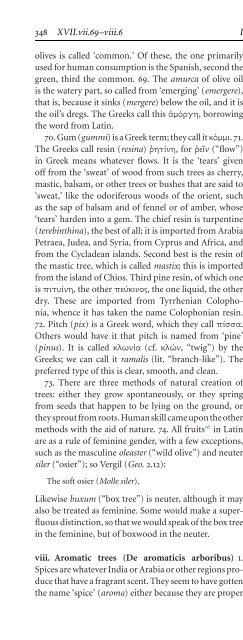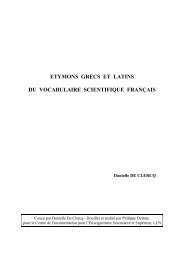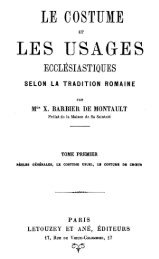The Etymologies of Isidore of Seville - Pot-pourri
The Etymologies of Isidore of Seville - Pot-pourri
The Etymologies of Isidore of Seville - Pot-pourri
Create successful ePaper yourself
Turn your PDF publications into a flip-book with our unique Google optimized e-Paper software.
348 XVII.vii.69–viii.6 <strong>Isidore</strong> <strong>of</strong> <strong>Seville</strong><br />
olives is called ‘common.’ Of these, the one primarily<br />
used for human consumption is the Spanish, second the<br />
green, third the common. 69. <strong>The</strong>amurca <strong>of</strong> olive oil<br />
is the watery part, so called from ‘emerging’ (emergere),<br />
that is, because it sinks (mergere)belowthe oil, and it is<br />
the oil’s dregs. <strong>The</strong> Greeks call this , borrowing<br />
the word from Latin.<br />
70.Gum(gummi)isaGreekterm; they call it . 71.<br />
<strong>The</strong> Greeks call resin (resina) , for (“flow”)<br />
in Greek means whatever flows. It is the ‘tears’ given<br />
<strong>of</strong>f from the ‘sweat’ <strong>of</strong> wood from such trees as cherry,<br />
mastic, balsam, or other trees or bushes that are said to<br />
‘sweat,’ like the odoriferous woods <strong>of</strong> the orient, such<br />
as the sap <strong>of</strong> balsam and <strong>of</strong> fennel or <strong>of</strong> amber, whose<br />
‘tears’ harden into a gem. <strong>The</strong> chief resin is turpentine<br />
(terebinthina), the best <strong>of</strong>all;itisimportedfromArabia<br />
Petraea, Judea, and Syria, from Cyprus and Africa, and<br />
from the Cycladean islands. Second best is the resin <strong>of</strong><br />
the mastic tree, which is called mastix; this is imported<br />
from the island <strong>of</strong> Chios. Third pine resin, <strong>of</strong> which one<br />
is ,theother ,the one liquid, the other<br />
dry. <strong>The</strong>se are imported from Tyrrhenian Colophonia,<br />
whence it has taken the name Colophonian resin.<br />
72. Pitch(pix) isaGreekword,which they call .<br />
Others would have it that pitch is named from ‘pine’<br />
(pinus). It is called (cf. , “twig”) by the<br />
Greeks; wecancall it ramalis (lit. “branch-like”). <strong>The</strong><br />
preferred type <strong>of</strong> this is clear, smooth, and clean.<br />
73. <strong>The</strong>reare three methods <strong>of</strong> natural creation <strong>of</strong><br />
trees: either they grow spontaneously, or they spring<br />
from seeds that happen to be lying on the ground, or<br />
they sprout from roots. Human skill came upon the other<br />
methods with the aid <strong>of</strong> nature. 74. All fruits 16 in Latin<br />
are as a rule <strong>of</strong> feminine gender, with a few exceptions,<br />
such as the masculine oleaster (“wild olive”) and neuter<br />
siler (“osier”); soVergil(Geo. 2.12):<br />
<strong>The</strong> s<strong>of</strong>t osier (Molle siler).<br />
Likewise buxum (“box tree”) is neuter, although it may<br />
also be treated as feminine. Some would make a superfluous<br />
distinction, so that we would speak <strong>of</strong> the box tree<br />
in the feminine, but <strong>of</strong> boxwood in the neuter.<br />
viii. Aromatic trees (De aromaticis arboribus) 1.<br />
Spices are whatever India or Arabia or other regions produce<br />
that have a fragrant scent. <strong>The</strong>y seem to have gotten<br />
the name ‘spice’ (aroma)either because they are proper<br />
for putting on altars (ara) forinvocations to the gods,<br />
or because they are known to blend and mingle themselves<br />
with air (aer). Indeed, what is scent if not air that<br />
has been tinctured by something? 2. Frankincense (tus)<br />
is a huge and well-branched tree <strong>of</strong> Arabia, with very<br />
smooth bark and branches like the maple’s, dripping a<br />
white, aromatic sap, like an almond tree, that is turned<br />
into apowderbychewing.Whenitisbrokenitisoily<br />
on the inside, and when set on fire it burns easily. Also<br />
we call it masculum because it is spherical in its nature<br />
like testicles (cf. masculus, “male”). Another type is flat<br />
and almost scaly, <strong>of</strong> lesser quality. It may be adulterated,<br />
mixed with resin or gum, but it can be distinguished by<br />
its properties, for frankincense, set on fire, burns, while<br />
resin fumes, but gum liquefies when heated. 3.Frankincense<br />
(tus)issocalled from ‘crushing’ (tundere). It is also<br />
called libanum after the mountain <strong>of</strong> Arabia where the<br />
Sabaeans dwell, for their mountain, where frankincense<br />
is gathered, is called Libanus.<br />
4. Myrrh(myrra) isatree<strong>of</strong>Arabia,five cubits high,<br />
and is like the thorn that they call (“acanthus”).<br />
Its sap is green and bitter (amarus), whence it takes the<br />
name myrra. <strong>The</strong> sap that flows spontaneously is more<br />
precious, while that drawn out by slashing the bark is<br />
considered poorer. From myrrh’s prunings the Arabs<br />
feed their fires, and unless they counteract it with the<br />
odor <strong>of</strong> storax, they contract many incurable diseases<br />
from its highly noxious smoke. Troglodyte myrrh is so<br />
called from an Arabian island where a better and purer<br />
form is gathered. 5. <strong>The</strong>storax (storax) isatree<strong>of</strong>Arabia,<br />
similar to the quince, whose shoots exude sap from<br />
their crevices during the rising <strong>of</strong> the dog star. When<br />
its distillate falls to the ground it is unclean, but when<br />
it is preserved in its own bark, it is clean. <strong>The</strong> distillate<br />
clinging to rods and reeds is clean and whitish, but then<br />
becomes yellowed because <strong>of</strong> the sun. <strong>The</strong> storax itself is<br />
reedy, oily, resinous, <strong>of</strong> pleasant odor, and moist, and it<br />
emits a sort <strong>of</strong> honey-like liquid. Moreover, storax is so<br />
called because the sap <strong>of</strong> this tree flows and is solidified,<br />
for the Greeks call a drop <strong>of</strong> sap an ‘icicle’ (stiria). In<br />
Greek the tree is called ,inLatin, storax.<br />
6. Bdellium is a tree <strong>of</strong> India and Arabia, and the sap <strong>of</strong><br />
the Arabic type is better. It is clear, whitish, smooth, oily,<br />
16 A scribal error <strong>of</strong> omission, preserved in Lindsay’s edition;<br />
rather read, “In Latin, people speak <strong>of</strong> all fruits as <strong>of</strong> neuter gender,<br />
but <strong>of</strong> trees for the most part as <strong>of</strong> feminine, with a few ...”

















